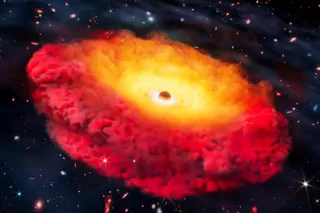High winds are the norm at the center of the Milky Way. Astronomers have now clocked suns orbiting the galactic core at a staggering 3,000 miles (4,800 kilometers) per second. At this rate, Earth would complete its orbit around the sun in a mere three days. What lurks at the galaxy’s core that can accelerate stars to such speeds?
Astronomers have considered various possibilities. Does the center of the galaxy harbor a tight cluster of superdense stellar remnants (neutron stars)? Or perhaps a huge ball of subatomic neutrino particles?
But these and other more exotic possibilities were eliminated in the spring of 2002 when a star called S2 swept down in its highly eccentric orbit and passed within 17 light-hours of the Milky Way’s center — a minuscule distance in galactic terms. In 17 hours, light travels three times the distance between Pluto and the sun.
Only one object is ...














